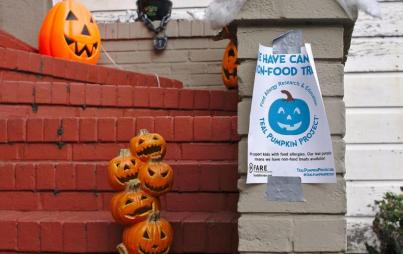
I’m not free of symptoms and I probably never will be. But the Low FODMAP diet helped me in more ways than decreasing my pain.
The first time I felt it, I thought I was having a heart attack. I was 14, and I crumbled into a ball on the gym floor during color guard practice. I had never felt pain so severe. I remember praying despite rejecting religion years earlier. I started going from doctor to doctor, and none of them seemed to believe that my pain was real. When I was 16, I had my gallbladder removed after my gastroenterologist found a polyp that he thought was causing the pain. Nothing improved. I did get a note to skip PE, though, which felt like a win.
Through the years, the pain came and went. But it was still lurking around the corner. My self-esteem plummeted. The gas and bloating were no joke. No matter how skinny I was, my stomach was nearly always distended, and I looked pregnant. I deliberately changed my wardrobe so that nothing was tight around my belly and began avoiding trips to the beach.
After graduating from college, things continued to get worse. I had to leave work early several times due to cramping and nausea. I started to dread parties where food was served. Something as healthy-sounding as a veggie and hummus platter would result in a quick, unannounced exit so I could deal with the pain on my own.
I was diagnosed with IBS, but I quickly learned it’s a BS, catch-all diagnosis for when doctors can’t figure out what’s wrong with you.
I tried everything to make my symptoms go away. I read all the blogs about improving digestion by eating raw foods, upping fiber, and taking probiotics. These just made me feel worse. I would later find out that I was actually getting too much fiber. I also tried going gluten-free for eight months. This didn’t help at all. I continued to try to eat healthily and followed all of the latest health advice and trends. Naturally, this included a lot of fruits and vegetables.
Eventually, after nearly ten years of symptoms, I started finding articles about the low FODMAP diet.
FODMAPs are short-chain carbohydrates that are poorly digested in some people. This leads to fermentation in the large intestine, which, in turn, causes the gastrointestinal symptoms we all know and love. These carbohydrates include:
- Fructose: honey, fruits such as apples and mangoes
- Lactose: milk and milk products
- Fructans: wheat, onions, garlic, asparagus
- Galactans: legumes such as chickpeas, beans, lentils
- Polyols: sugar alcohols, which are often used as sweeteners, as well as fruits and veggies such as avocado, cauliflower, and mushrooms
You’ll notice that this list is filled with many of the healthy foods that nutritionists recommend.
The Low FODMAP diet was created by researchers at Monash University in Australia. It was initially designed to be a short-term elimination diet for those suffering from IBS but has been extended to other digestive and autoimmune disorders.
During the elimination phase, a strict low FODMAP diet is followed for three to eight weeks. High FODMAP foods are completely avoided, but it is equally important to only consume low FODMAP foods in moderation. The idea is to then gradually add groups back one at a time to discover which ones personally cause you problems. The diet is designed to be followed only with the guidance of a dietician to avoid malnutrition.
You Might Also Like: Listen To Your Gut: My Journey With SIBO, Digestive Healing, And Self-Care
I’m not going to lie. The elimination phase was incredibly tricky and adding foods back was scary. What if I added something back in too high of a quantity? How would I know if I had to avoid a food entirely or just limit my intake? I learned that it was a matter of being realistic while keeping my irritants as low as possible. It’s not an exact science, and it required a lot of playing around. For instance, I quickly learned that onions and garlic were in everything! It’s impossible to avoid them while eating out. However, I found that if I consume a small amount in a sauce or dressing, it doesn’t bother me nearly as much as if it’s a main ingredient of the dish. On the other hand, even one small apple will give me pain for hours.
I’m not free of symptoms and I probably never will be. But the Low FODMAP diet helped me in more ways than decreasing my pain.
It made me aware of how blindly we follow the advice of others, whether they’re bloggers or even medical professionals.
Even those who don’t trust doctors often try to preach one remedy or another without realizing that there is no “one-size-fits-all.”
For example, many people tout the benefits of going gluten-free.
In reality, unless you’re allergic, eliminating gluten isn’t necessary. However, the reason that some people may find some relief in getting rid of gluten is not the gluten itself, but the fact that most gluten products contain high levels of FODMAPs. Still, replacing them with processed, gluten-free foods likely won’t help, since the irritants are still present in these substitutes.
When I wrote about my experience with FODMAPs on my blog, I received harsh comments from people criticizing that I was sharing recipes that deliberately avoided onions and garlic. They said that it was shameful for me to disparage foods that are “essential” to healthy immune function. I never recommended that people avoid these foods; I only shared that limiting them had helped me with my particular issues. These attacks further highlight the problem: we read that something is healthy or unhealthy, so we apply it to everything and everyone.
The takeaway point here isn’t to go ahead and try this diet, so much as to explore and learn what works for your own physical and mental health. I never knew that healthy foods could hurt me. A kale smoothie might be trendy, but I am my best on a big bowl of oatmeal and mushy bananas.








